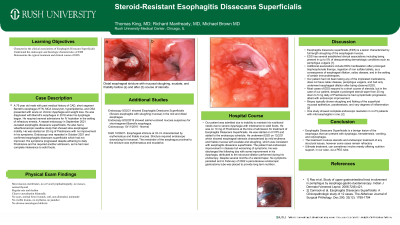Back


Poster Session D - Tuesday Morning
Category: Esophagus
D0248 - Steroid-Resistant Esophagitis Dissecans Superficialis With Recurrent Stricturing
Tuesday, October 25, 2022
10:00 AM – 12:00 PM ET
Location: Crown Ballroom

Has Audio
- TK
Thomas King, MD
Rush University Medical Center
Chicago, IL
Presenting Author(s)
Thomas King, MD, Richard A. Manfready, MD, AM, Michael Brown, MD
Rush University Medical Center, Chicago, IL
Introduction: Esophagitis dissecans superficialis (EDS) is a rare endoscopic finding characterized by sloughing of esophageal mucosa. Dysphagia, regurgitation of casts, and vomiting can result from superficial mucosal stripping. Histologically, the epithelium is split above the basal layer. Cases may be associated with desquamating dermatologic conditions such as pemphigus vulgaris, or due to bisphosphonates, chemical irritants, or autoimmune conditions. EDS is a benign condition, and most cases respond to a short course of steroids with rapid symptomatic and histologic improvement. Chronic cases are very rare. We present a rare case of structuring EDS that did not respond to steroids or serial dilations.
Case Description/Methods: A 79-year-old man with a history of short-segment nondysplastic Barrett’s esophagus presented with progressive dysphagia to solids, vomiting, and weight loss. Index upper endoscopy revealed severe esophagitis with peeling white strips of mucosa and a 7 mm lumen in the distal esophagus. Histology showed necrotic fragments of epithelium with minimal focal inflammation and granulation tissue without intestinal metaplasia, eosinophilia, bacterial colonies, or fungal organisms on special staining. Findings were consistent with EDS. When symptoms failed to respond to acid suppression alone, he was started on 20 mg of prednisone daily. The stricture was balloon dilated with temporary relief. Over the course of the next year, the patient presented monthly with severe dysphagia requiring repeat stricture dilation and triamcinolone injection. Stricturing and sloughing persisted despite an empiric trail of 40 mg of prednisone daily, pantoprazole, and high-dose famotidine. Repeat biopsies remained consistent with EDS. Workup was negative for inflammatory and autoimmune conditions, including IgG4. Esophageal motility on high-resolution manometry was normal apart from a high-pressure zone at the stricture. The patient eventually required a gastrostomy tube for nutrition.
Discussion: EDS, a form of desquamative esophagitis, is typically self-limiting or responds readily to steroids. Stricturing EDS is a rare entity described infrequently in case reports, which have identified etiologies such as esophageal IgG4 disease. Our patient did not have any of the common risk factors given the absence of dermatologic and autoimmune conditions and the lack of culprit medications. The presence of recurrent debilitating strictures may necessitate alternative therapies such as biologic therapy or surgery.

Disclosures:
Thomas King, MD, Richard A. Manfready, MD, AM, Michael Brown, MD. D0248 - Steroid-Resistant Esophagitis Dissecans Superficialis With Recurrent Stricturing, ACG 2022 Annual Scientific Meeting Abstracts. Charlotte, NC: American College of Gastroenterology.
Rush University Medical Center, Chicago, IL
Introduction: Esophagitis dissecans superficialis (EDS) is a rare endoscopic finding characterized by sloughing of esophageal mucosa. Dysphagia, regurgitation of casts, and vomiting can result from superficial mucosal stripping. Histologically, the epithelium is split above the basal layer. Cases may be associated with desquamating dermatologic conditions such as pemphigus vulgaris, or due to bisphosphonates, chemical irritants, or autoimmune conditions. EDS is a benign condition, and most cases respond to a short course of steroids with rapid symptomatic and histologic improvement. Chronic cases are very rare. We present a rare case of structuring EDS that did not respond to steroids or serial dilations.
Case Description/Methods: A 79-year-old man with a history of short-segment nondysplastic Barrett’s esophagus presented with progressive dysphagia to solids, vomiting, and weight loss. Index upper endoscopy revealed severe esophagitis with peeling white strips of mucosa and a 7 mm lumen in the distal esophagus. Histology showed necrotic fragments of epithelium with minimal focal inflammation and granulation tissue without intestinal metaplasia, eosinophilia, bacterial colonies, or fungal organisms on special staining. Findings were consistent with EDS. When symptoms failed to respond to acid suppression alone, he was started on 20 mg of prednisone daily. The stricture was balloon dilated with temporary relief. Over the course of the next year, the patient presented monthly with severe dysphagia requiring repeat stricture dilation and triamcinolone injection. Stricturing and sloughing persisted despite an empiric trail of 40 mg of prednisone daily, pantoprazole, and high-dose famotidine. Repeat biopsies remained consistent with EDS. Workup was negative for inflammatory and autoimmune conditions, including IgG4. Esophageal motility on high-resolution manometry was normal apart from a high-pressure zone at the stricture. The patient eventually required a gastrostomy tube for nutrition.
Discussion: EDS, a form of desquamative esophagitis, is typically self-limiting or responds readily to steroids. Stricturing EDS is a rare entity described infrequently in case reports, which have identified etiologies such as esophageal IgG4 disease. Our patient did not have any of the common risk factors given the absence of dermatologic and autoimmune conditions and the lack of culprit medications. The presence of recurrent debilitating strictures may necessitate alternative therapies such as biologic therapy or surgery.

Figure: Distal esophageal desquamation and stricturing
Disclosures:
Thomas King indicated no relevant financial relationships.
Richard Manfready indicated no relevant financial relationships.
Michael Brown indicated no relevant financial relationships.
Thomas King, MD, Richard A. Manfready, MD, AM, Michael Brown, MD. D0248 - Steroid-Resistant Esophagitis Dissecans Superficialis With Recurrent Stricturing, ACG 2022 Annual Scientific Meeting Abstracts. Charlotte, NC: American College of Gastroenterology.
